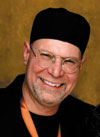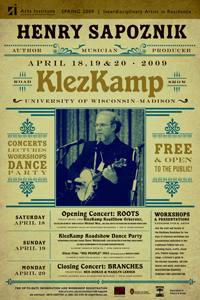Artist celebrates Yiddish music with ‘KlezKamp’
If Henry Sapoznik has his way, Madison will become the capitol of “Yiddishland” during a three-day “KlezKamp Road Show,” a celebration of klezmer music and Yiddish folk arts Saturday–Monday, April 18–20.

Sapoznik.
KlezKamp is part of Sapoznik’s stay on campus as the spring UW–Madison Arts Institute Interdisciplinary Artist in Residence. The event will feature concerts by national and local klezmer performers as well as workshops, films, lectures and a dance party.
Sapoznik, award-winning author, scholar, record and radio producer, and performer of traditional Yiddish and American music, is credited with the late 20th century revival of klezmer, traditional Yiddish music from Eastern European shtetls.
Klezmer isn’t “Hava Nagila” or “Fiddler on the Roof” — it’s roots music that can be raw and wild, jazzy and bluesy, or plaintive and prayerful. “To say that ‘Fiddler’ represents klezmer culture is to say that ‘Brigadoon’ represents Scottish culture,” laughs Sapoznik. Whatever its mood, klezmer is contagious and embraces the language, history and culture of the people who lived it.

Madison will become the capitol of “Yiddishland” during a three-day “KlezKamp Road Show,” a celebration of klezmer music and Yiddish folk arts Saturday–Monday, April 18–20.
Klezmer is just one aspect of Yiddish culture being studied in a class Sapoznik is teaching as part of his residency, “Yiddish-American Popular Culture 1890–1950.” Using period media such as 78 rpm recordings, cartoons, films and radio broadcasts, the class is examining how the nascent and vibrant culture of East European Jews arriving in American at the end of the 19th century interacted with, influenced and portrayed simultaneously emerging American popular culture. “Academia was the last place I expected klezmer to end up,” says Sapoznik.
He says no two students in his class have the same background and not all are Jewish. Surprisingly, there are no music majors, but theater, Spanish and art are represented. There are also some Jewish adults from the community auditing the class. A seasoned lecturer and teacher, Sapoznik says his past students usually had some knowledge of or experience with Yiddish cultural references. Not so here. “I had to throw my syllabus out the window. I am learning as much as they are,” says Sapoznik.
Sapoznik has his students conducting original research, much as he did when he was learning about klezmer culture and music. “I sent them to my sources, and I am so proud of them. This is not airless, dusty history; this is a tactile, volatile folk culture that is still within living history,” says Sapoznik. “They are learning how to question received wisdom. We must understand people without dehumanizing them by creating new stereotypes. I want my students to learn how to interpret cultures,” says Sapoznik.
Sapoznik, too, has received a lot of wisdom over the years. Klezmer was traditionally passed down to younger generations from older musicians teaching the young, ensuring new guardians of a culture. But by the 1970s, interest in klezmer had faded and there were few in line ready to keep the cultural threads alive.
Sapoznik, though, was smitten by folk culture and started out learning the ways of country and bluegrass music. Life took a different course when one of his bluegrass mentors asked him, “Don’t none of your people [Jews] have their own music?” He realized he had been ignoring his own traditions. “Klezmer was so everyday,” says Sapoznik.
When he first started learning klezmer, Sapoznik couldn’t get enough. “I loved being the worst musician on the bandstand because I knew I was surrounded by greatness, and everywhere I turned there was something to learn. Now I’m one of the old guys,” he laughs. “I’ve toured the world many times, been to the Grammys, but my students here are giving me one of the best experiences I’ve ever had.”
The upcoming KlezKamp will be the first held in the Midwest. For 24 years, some 20,000 people from all over the world have attended Sapoznik’s KlezKamps held each year in the northeastern United States. The event includes concerts, lectures, workshops and a dance party. He knows it will be a challenge, but he hopes to build an orchestra in a day.
An opening concert featuring the KlezKamp Roadshow Orchester, along with local artists Yid Vicious and the Madison Yiddish Choir, will be held at 7 p.m. on Saturday, April 18, in Morphy Hall at the Mosse Humanities Building.
On Sunday, April 19, activities include a screening of a silent film, “His People,” at 6 p.m. in the Cinematheque, 4070 Vilas Hall; and a dance party at 8 p.m. at Temple Beth El, 2702 Arbor Drive. Steve Weintraub will be on hand to lead instruction in traditional Yiddish dances.
A closing concert featuring Ben Sidran and Marilyn Lerner will take place at 7 p.m. on Monday, April 20, at Morphy Hall.
Some workshops on the schedule include “The Story of Yiddish: ‘Born to Kvetch,’” “Vocal Sources of Yiddish Music,” “Old-time Yiddish Dance,” and “The Hows and Whys of a Klezmer Band.” All KlezKamp events are free and open to the public, but pre-registration for the workshops is required.
For more information on Sapoznik’s residency, the UW–Madison Arts Institute, a complete list of KlezKamp events and to register for workshops, visit Interdisciplinary Arts Residency.




